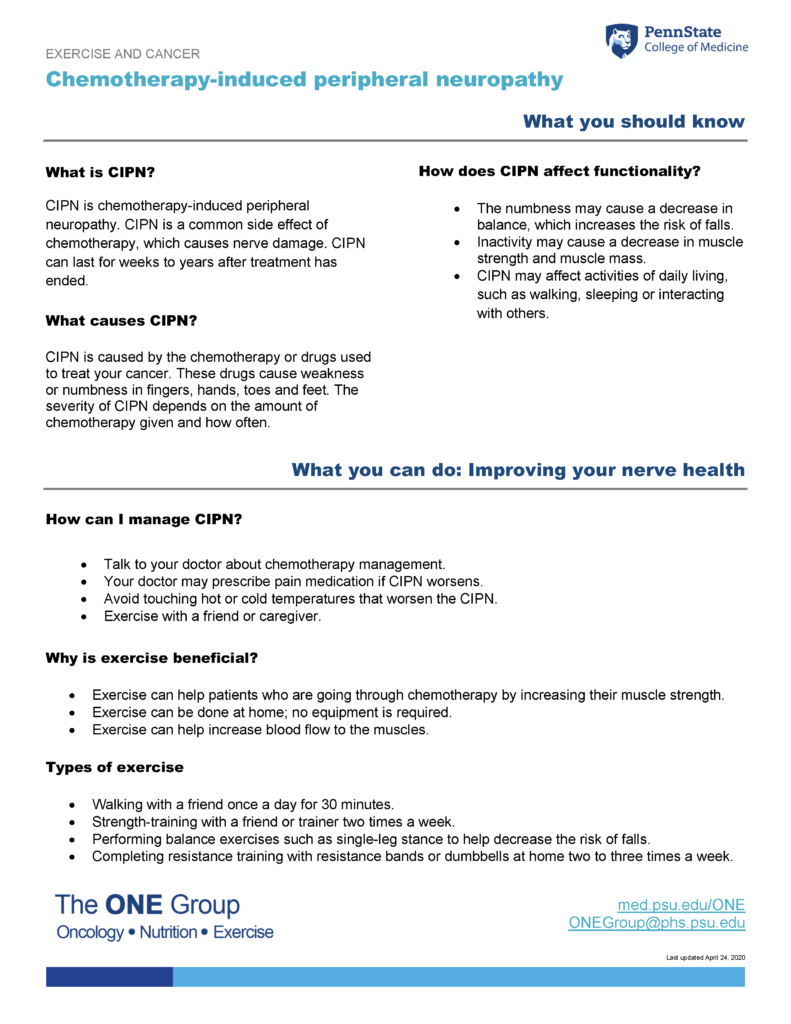Learn about chemotherapy-induced peripheral neuropathy in people with cancer in this guide from The ONE Group (Oncology – Nutrition – Exercise) at Penn State College of Medicine.
Jump to topic
Search
What you should know
What is CIPN?
CIPN is chemotherapy-induced peripheral neuropathy. CIPN is a common side effect of chemotherapy, which causes nerve damage. CIPN can last for weeks to years after treatment has ended.
What causes CIPN?
CIPN is caused by the chemotherapy or drugs used to treat your cancer. These drugs cause weakness or numbness in fingers, hands, toes and feet. The severity of CIPN depends on the amount of chemotherapy given and how often.
How does CIPN affect functionality?
- The numbness may cause a decrease in balance, which increases the risk of falls.
- Inactivity may cause a decrease in muscle strength and muscle mass.
- CIPN may affect activities of daily living, such as walking, sleeping or interacting with others.
What you can do: Improving your nerve health
How can I manage CIPN?
- Talk to your doctor about chemotherapy management.
- Your doctor may prescribe pain medication if CIPN worsens.
- Avoid touching hot or cold temperatures that worsen the CIPN.
- Exercise with a friend or caregiver.
Why is exercise beneficial?
- Exercise can help patients who are going through chemotherapy by increasing their muscle strength.
- Exercise can be done at home; no equipment is required.
- Exercise can help increase blood flow to the muscles.
Types of exercise
- Walking with a friend once a day for 30 minutes.
- Strength-training with a friend or trainer two times a week.
- Performing balance exercises such as single-leg stance to help decrease the risk of falls.
- Completing resistance training with resistance bands or dumbbells at home two to three times a week.
Exercises for balance
Heel-to-toe walk
Walk in a straight line, placing your heel directly in front of your toes on the other foot.
Assisted single-leg stance
Raise one leg up, place your arms out and hold for 10 seconds. Switch legs and do the same. Do this three times for each leg.
Toe touch
Place one foot six inches behind the other, bend down and try to touch your toes; hold for 10 seconds. Do this three times per side.
Where can I find more information about aerobic and strength-training exercises?
If you are interested in starting aerobic and/or strength-training exercises, The ONE Group (Oncology – Nutrition – Exercise) provides videos demonstrating proper form for more than 50 exercises.
Notes
Considerations
- If you experience any difficulty with your activities of daily living, consult your doctor.
- Don’t overwork yourself; be sure to take rests when you need them.
References
- Dana-Farber Cancer Institute
- Intech Open
- Ovid
- UpToDate

